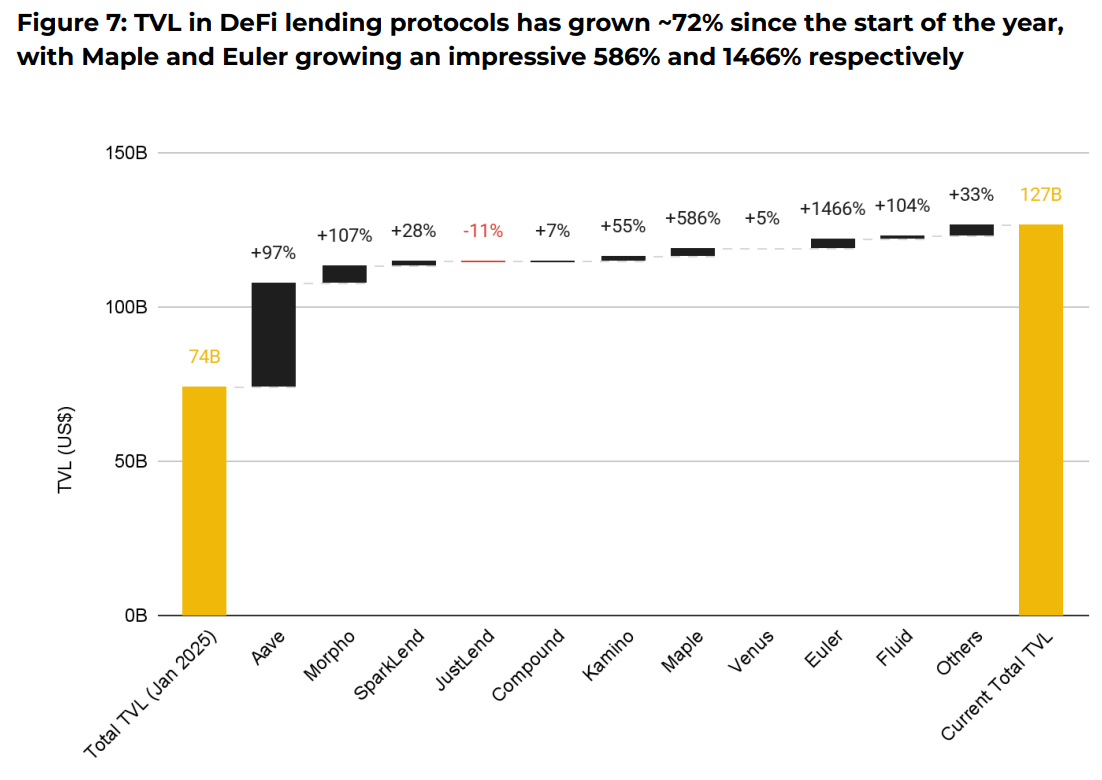DeFi lending is rapidly expanding as institutional adoption of stablecoins and tokenized RWAs enables borrowers to use real‑world assets as collateral, driving TVL growth and new institutional products that bridge TradFi liquidity with decentralized credit markets.
-
DeFi lending TVL jumped 72% YTD to $127B, driven by stablecoins and tokenized RWAs.
-
Institutional-grade offerings such as Aave Labs’ Horizon let tokenized RWAs secure stablecoin loans.
-
Onchain RWAs total $27.8B: $15.9B private credit and $7.4B US Treasuries, signaling growing institutional use.
DeFi lending growth driven by tokenized RWAs and stablecoins, boosting institutional access to decentralized credit — read the latest analysis and implications.
What is DeFi lending and why is it rising?
DeFi lending is an automated system that enables borrowing and lending via smart contracts without intermediaries. It is rising because institutional acceptance of stablecoins and tokenized real‑world assets (RWAs) is expanding collateral options and unlocking new liquidity for decentralized credit markets.
Decentralized lending protocols facilitate permissionless access to credit, using onchain collateral models and algorithmic risk controls. According to Binance Research, total value locked (TVL) in DeFi lending rose from $53 billion to over $127 billion year‑to‑date, a 72% increase.

DeFi lending protocols, TVL, year-to-date chart. Source: Binance Research
How are tokenized RWAs changing DeFi lending?
Tokenized RWAs—digital representations of private credit, US Treasuries and other financial instruments—are broadening acceptable collateral sets for DeFi lending. RWA.onchain data shows $27.8 billion in total RWAs, with $15.9 billion in tokenized private credit and $7.4 billion in tokenized US Treasuries. This shift enables institutions to use yield‑bearing, regulated assets to secure stablecoin loans.
Products like Aave Labs’ Horizon are specifically designed as institutional lending markets that accept tokenized RWAs as collateral for stablecoin borrowing. These markets aim to convert TradFi liquidity into productive assets for DeFi, supporting larger loan sizes and lower counterparty friction.

RWA global dashboard. Source: RWA.xyz
What risks do RWA-collateralized DeFi loans introduce?
Using tokenized US Treasuries and other TradFi assets as DeFi collateral can create new risk transmission pathways. A June report from Moody’s warned that leveraging US Treasuries for crypto trading can generate cascading liquidity effects and cross‑market contagion. Protocols must manage yield volatility, custody risk, and regulatory constraints to limit systemic exposure.
Frequently Asked Questions
How big is the recent DeFi lending growth?
DeFi lending TVL rose approximately 72% year‑to‑date, increasing from $53 billion at the start of 2025 to over $127 billion, driven largely by institutional stablecoin demand and tokenized RWAs.
Can institutions use tokenized RWAs as collateral today?
Yes. Institutional markets like Aave Labs’ Horizon enable tokenized RWAs to secure stablecoin loans, allowing institutions to deploy onchain assets such as private credit and tokenized Treasuries into decentralized lending.
How can institutions integrate RWAs into DeFi lending?
Institutions typically follow a phased approach: tokenize eligible TradFi assets, ensure compliant custody and onchain provenance, list tokenized instruments on supported markets, and access lending markets that accept those tokens as collateral.
- Tokenize regulated assets with clear legal wrappers.
- Verify custody and audit trails for onchain provenance.
- Use institutional lending rails such as Aave Labs’ Horizon to collateralize stablecoin borrowing.
- Monitor counterparty and liquidity risk continuously.
Key Takeaways
- DeFi lending expansion: TVL surged 72% YTD to $127B as institutions adopt stablecoins and RWAs.
- RWA composition: Onchain RWAs total $27.8B, led by $15.9B private credit and $7.4B US Treasuries.
- Risk management: Tokenized Treasuries introduce new transmission risks; protocols must bolster custody, transparency, and stress testing.
Conclusion
DeFi lending is maturing into an institutional venue as tokenized RWAs and stablecoins expand usable collateral sets. Protocols and institutions must balance new liquidity opportunities with strengthened risk controls. Expect continued innovation in institutional‑grade products and rigorous risk frameworks as DeFi integrates more TradFi liquidity.
DeFi lending is poised to capture more institutional interest as tokenized RWAs are increasingly accepted as collateral for stablecoin loans, according to Binance Research.
Decentralized lending protocols are surging in total value, set to further capitalize on the growing institutional adoption of stablecoins and tokenized assets, according to Binance Research.
Decentralized finance (DeFi) lending protocols are automated systems that facilitate lending and borrowing for investors via smart contracts, eliminating the need for financial intermediaries such as banks.
DeFi lending protocols rose over 72% year-to-date (YTD), from $53 billion at the beginning of 2025 to reach over $127 billion in cumulative total value locked (TVL) on Wednesday, according to Binance Research.
The explosive growth is attributed to DeFi lending protocols benefiting from the accelerated institutional adoption of stablecoins and tokenized real-world assets (RWAs).
Binance Research noted that as stablecoin and tokenized asset adoption accelerates, DeFi lending protocols are increasingly positioned to facilitate institutional participation.
A significant portion of this growth was attributed to Maple Finance and Euler, which saw an explosive 586% and 1466% rise, respectively.
Crypto adoption commentary: the market is one growth cycle away from mainstream adoption, targeting billions of users.
DeFi lending to capture more institutional participation from RWA collateral adoption
Binance Research sees DeFi lending protocols as growing facilitators of institutional participation, specifically due to the launch of institutional‑grade products, such as Aave Labs’ Horizon.
Horizon is an institutional lending market that enables borrowers to use tokenized RWAs as collateral for stablecoin loans.
Products like Horizon aim to unlock new liquidity and convert RWAs into productive assets within the decentralized finance ecosystem, the report says.
Tokenized financial products, such as private credit and US Treasury bonds, became a focal point of institutional interest. Tokenized private credit represents the majority—$15.9 billion—of the total $27.8 billion RWAs onchain, followed by $7.4 billion worth of US Treasuries, based on data from RWA.xyz.
Some RWA protocols enable the use of yield-bearing tokenized US Treasury products as collateral for multiple DeFi activities.
However, using US Treasuries as collateral for leveraged crypto trading created new risk transmission pathways across markets, such as cascading effects for DeFi protocols, according to a June report from Moody’s.
Magazine coverage notes: Ethereum leads TradFi tokenization efforts, intensifying competition in a multi‑trillion dollar market.
